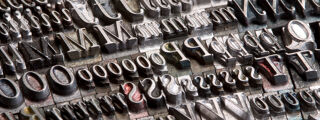Piloting an interdisciplinary approach to investigating the master punches of John Baskerville.
Researchers
- Caroline Archer
- Ann-Marie Carey
- Keith Adcock
- Maciej Pawlikowski - Digital Content Unit, University of Cambridge
- Dippal Manchanda - Birmingham Assay Office
Research background
The Baskerville font was designed by John Baskerville an eighteenth-century Birmingham printer who considered all aspect of the printing process, from the design of the thick and thin strokes of each letter which assisted in the legibility of the character to the cutting the letter face into the three dimensional punch tool, along with the type setting and quality of the ink that transferred the letter to the page.
While there are many eighteenth-century books containing Baskerville’s front, the books represent the final accumulative stage in a journey of craftsmanship that created his books.
It is the transformative journey of craftsmanship, the material aspects of the master punches manufacture that is this projects focus. Baskerville’s workshop has not survived nor has any documentation with regard to his workshop practices.
Therefore, his punches, the tools of printing, are the primary source of evidence connecting Baskerville to his craftsmanship. If we can understand the craftsmanship of the punches we will gain insights into the manufacture of the Baskerville punches.
The punches are owned by Cambridge University Press and housed in the Historical Printing Room at the University Library Cambridge. The collection consist of approximately 2750 punches according to the records made at the time when the punches were donated to Cambridge in 1953.
Research aims
The aim of this project was to pilot an interdisciplinary approach to investigating the punches, utilising a combination of digital technology investigated through the lens of craftsmanship, detailed photogrammetry (Reflective Transformative Image) and metallurgy, to interpret and reveal the hidden craft processes and original intent embedded within these punches.
How has the research been carried out?
The project was a collaboration between the Centre for Printing History and Culture, Centre for Digital Design and Manufacture at the School of Jewellery, Digital Content Unit Cambridge University and the Birmingham Assay Office. Importantly the collaboration brought together a range of disciplines each with their own underpinning subject expertise and methodological approach.
Collectively this provided an original methodology to allow for the visual, physical and material analysis of the punches.
For the purposes of this exploratory study and for means of comparison, the single letter form of the lower case g in 10 different point sizes from 14-60 was selected. The sampling represents a fine example of the distinct thick and thin weighting of the strokes, a recognisable characteristic of the Baskerville font. The ‘face‘of the punch has always drawn the eye as the final process of punch cutting and the height of craftsmanship, it is also the most easily understood aspect of the punch.
The shank in contrast has often been overlooked disregarded due to its rough and raw finish, however these ‘workshop’ surfaces have been left and bear witness to the marks of manufacture - witness marks. Could deciphering these marks provide valuable clues to the skills, level of technology and material understanding required for their manufacture?
Data capture, laser scanning is a non-invasive process were the object is held in a jig and the articulated arm moves around the artefact to capture scans from various perspectives. Using 3 points of reference on the artefact the software complies the digital scans and stitches them together to create a virtual point could of data, as such a digital skin of the high and low points representing the topology of the surface and accurately capturing the size scale and texture of the punch.
A primary aim of this project was the integration of multiple methods of data collection which in combination would provide an original methodology with cross disciplinary outputs. Reflective Transformation Imaging RTI a specialist photographic method used by the Digital Content Unit Cambridge University uses multiple images of the same object to create textured images of the punch face.
The ability to overlay data sets (3D laser scanning, RTI, and modern Baskerville fonts) provides useful comparative analysis, e.g. in the modern version the strokes are notably thicker in areas and have lost some of the elegance and movement of the strokes.
Outcomes and impact
The punches are the closest evidence of Baskerville’s original intent for the design of his font, and the only remaining primary evidence of Baskerville’s craftsmanship, this project highlights an under research aspect of Baskerville’s work. This project has established the efficacy of a multidisciplinary and multimethod approach to extend our understanding and knowledge of the Baskerville font.
This pilot study was supported by History West Midlands with a grant of £12,000.
Journal article
Archer-Parré, Caroline, Ann-Marie Carey, and Keith Adcock, ‘The Baskerville Punches: Revelations of Craftsmanship’, Midland History, 45.2 (2020), 176–89
- https://www.tandfonline.com/doi/abs/10.1080/0047729X.2020.1767973
- http://www.open-access.bcu.ac.uk/9441/
Additional links
Short Film John Baskerville - The lasting legacy of Birmingham’s famous printer on Vimeo
Research Catalogue REVELATIONS OF CRAFTMANSHIP by Ann-Marie Carey (researchcatalogue.net)
